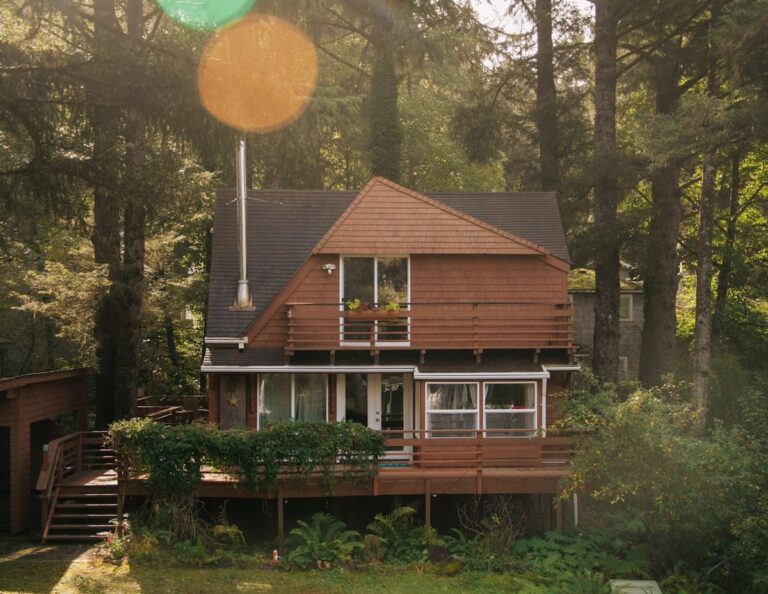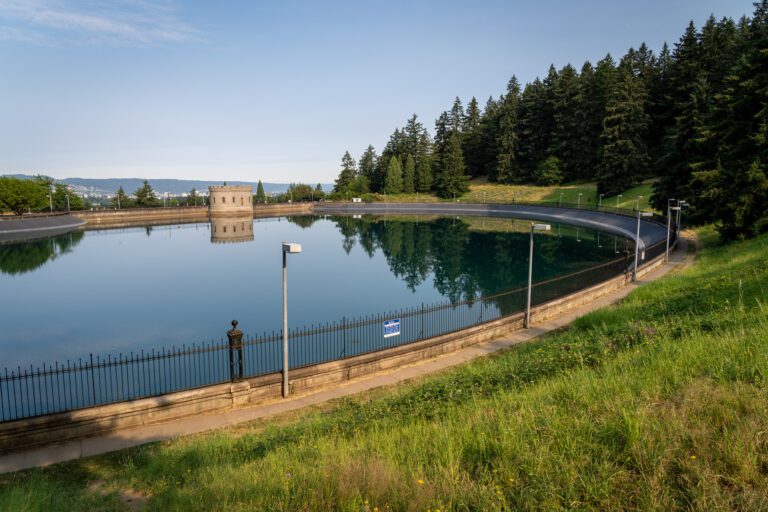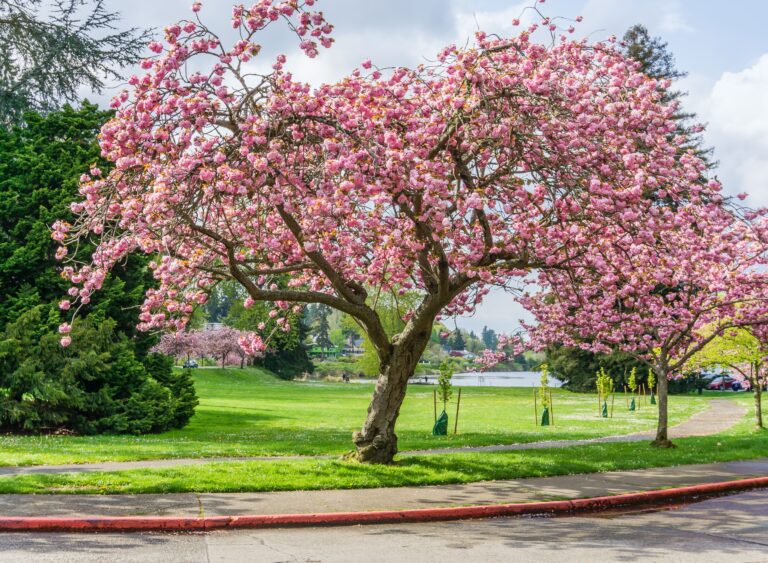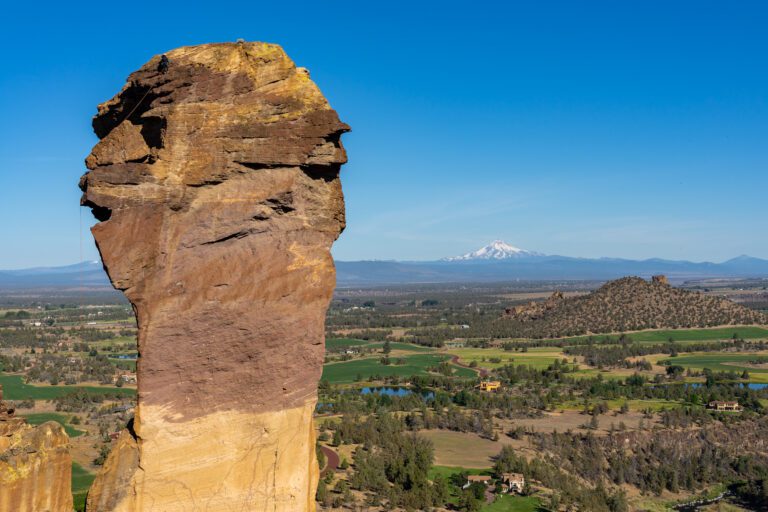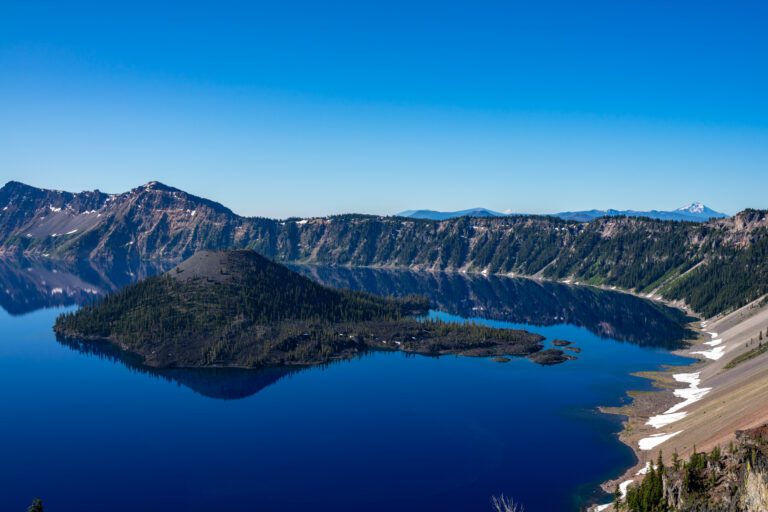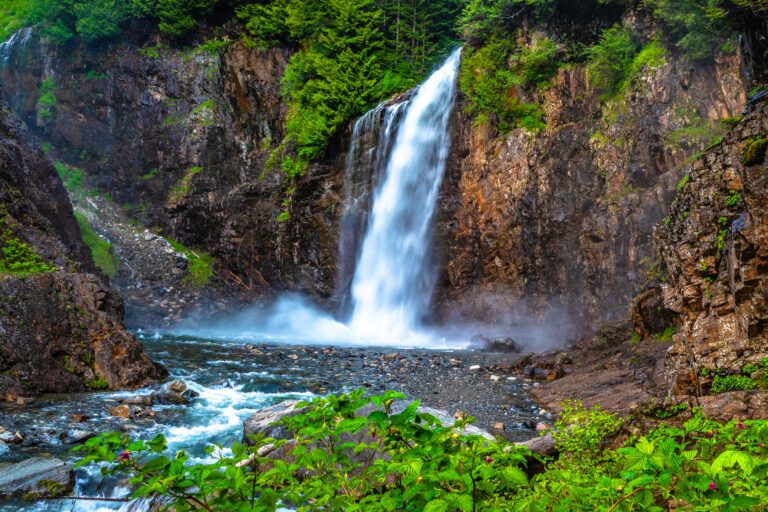15 Incredible Waterfalls in Washington For Your Bucket List
From rainforests and snow-dusted mountains, to alpine lakes and wind-swept coasts, the landscapes of Washington State boast an incredible diversity that never ceases to amaze. What do each of these environments have in common? Mesmerizing waterfalls cascading through forests, over cliffs, and down mountainsides into spectacular plunge pools.
There is certainly no shortage of waterfalls in Washington State, from the arid canyons of eastern Washington to the lush rainforest of the Olympic Peninsula, or the alpine region of the Cascade Mountains.
There is a Washington waterfall for everyone, whether you’re seeking a stop-off on a road-trip or a challenging hike through lush terrain to reach incredible falls at the end.
As someone who was born in Washington State and who has called Washington home on and off throughout her life, I’ve made it my mission to scour each corner of the region in search of the best experiences.
An outdoor enthusiast who thrives off of nature, I’ve frequented falls across the state on weekend excursions and countless hiking adventures. Below is a guide to help you explore some of the best waterfalls in Washington State.
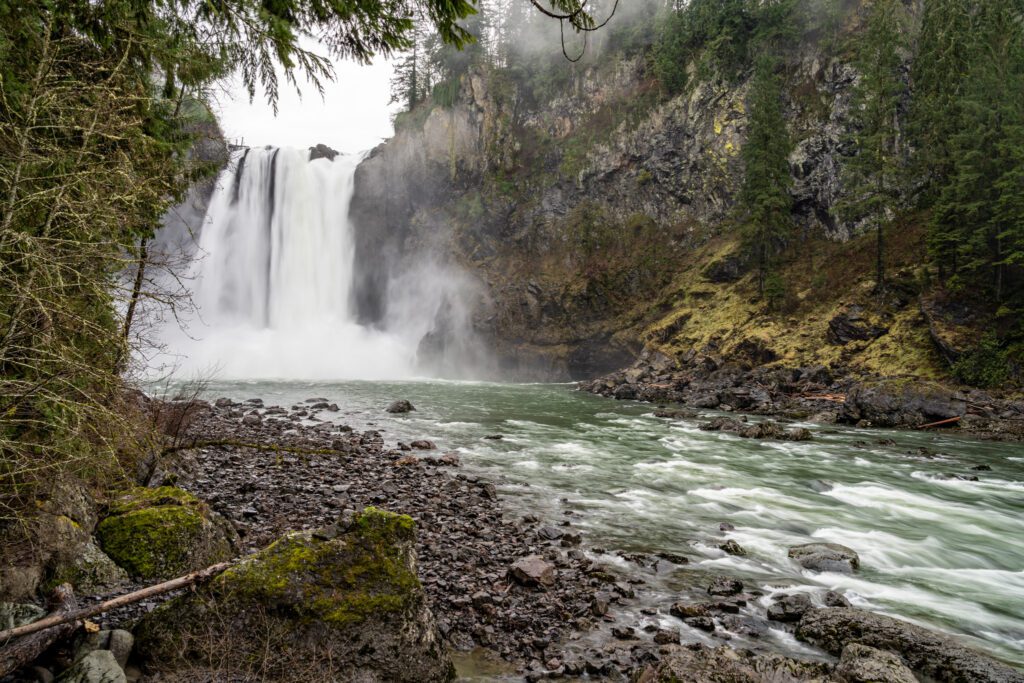
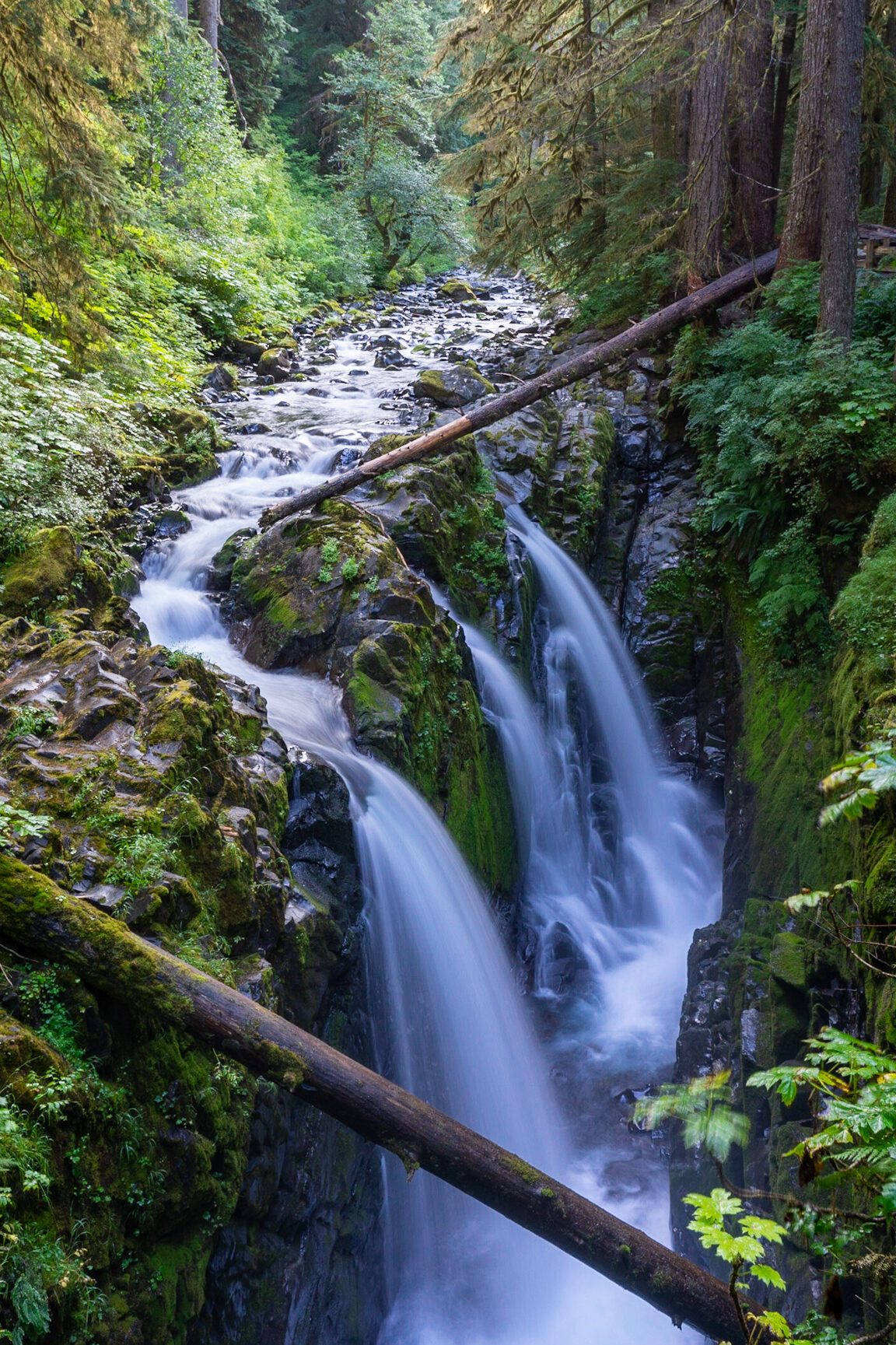
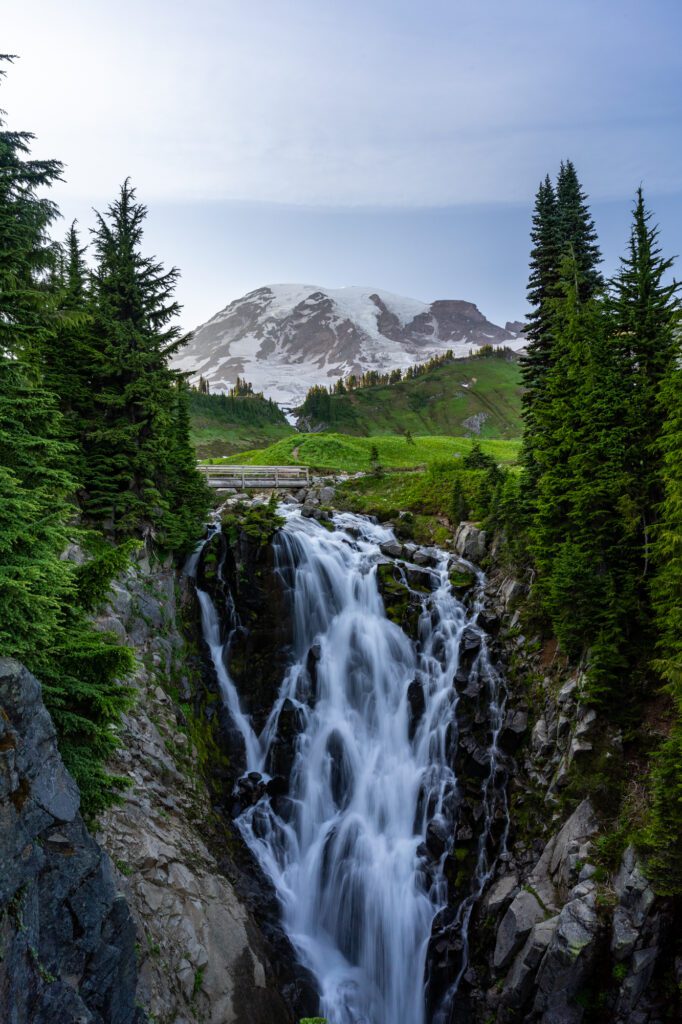
Disclaimer: Some of the links below are affiliate links, which means that if you click on one and purchase something, we make a small portion of the sale at no additional cost to you. It goes without saying that we would never recommend something we wouldn’t use or do ourselves.
15 Gorgeous Waterfalls in Washington State to Add to Your Bucket List
Here are 15 beautiful waterfalls in Washington State, along with all the information you need to experience them.
Palouse Falls
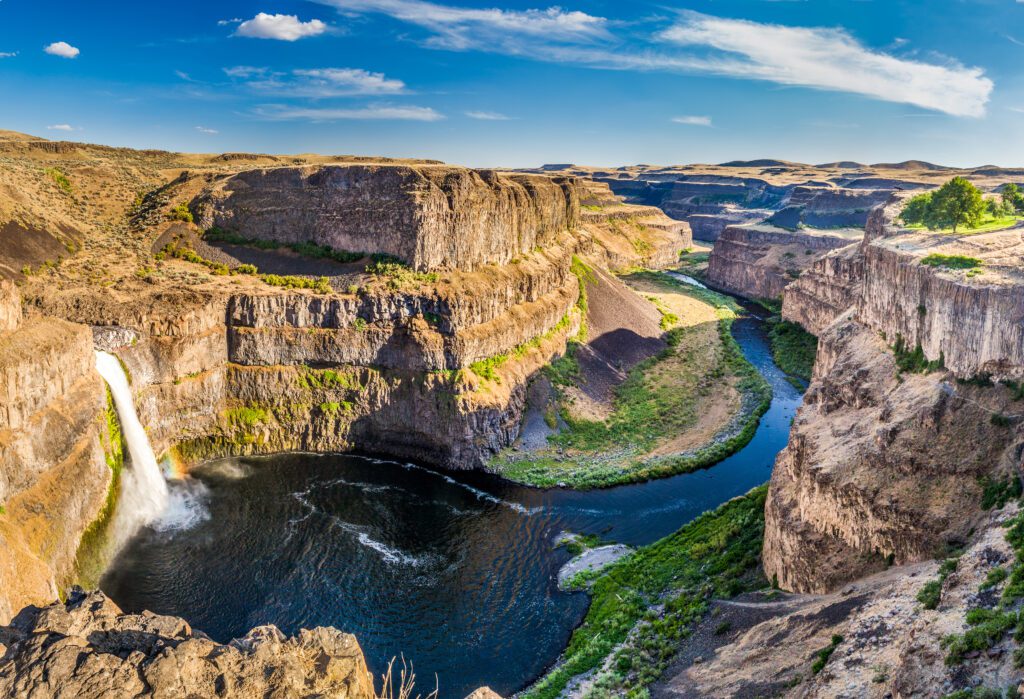
- Region: Eastern Washington (Palouse Falls State Park)
- Drive Time / Distance From Seattle: 4 hours / 235 miles
- Pass Required: Discover Pass
- Hike Distance: 1 mile
- Elevation Gain: 0 feet
- Trailhead Location
The spectacular Palouse Falls cascade 198 feet down into the Palouse River. These already phenomenal falls are made even more impressive by the dramatic basalt cliffs that surround them.
At the end of the last ice age, glacial floods swept across Eastern Washington, carving the coulees and plateaus preserved landscape today. This makes for quite a distinct feel from the alpine and forest landscapes characteristic of the regions west of the Cascades. Palouse Falls are one of the last remnants of this ancient natural phenomena.
As of 2014, Palouse Falls was deemed the official waterfall of Washington State and the magnificent sight does live up to its status. Located in southeastern Washington, the state’s infamous falls are a journey to reach wherever you live in Washington.
A four-hour drive from Seattle across the mountains and down south, or a nearly two-hour trek driving southwest from Spokane, Palouse Falls are located in the aptly named Palouse Falls State Park just past the tiny town of Washtucna.
There is a sizable parking lot in the park from which you can follow a short, gravel path for about a half of a mile to reach Palouse Falls. Catch views over the canyons and falls as you walk through grassland splashed with colorful wildflowers.
Keep your eyes out for rattlesnakes as you are in rattlesnake country, after all.
If you wish to stay and enjoy the beauty of the park, there is a campground with 11 tent spaces that allow you to make a weekend excursion in this remote region of southeastern Washington.
Marymere Falls
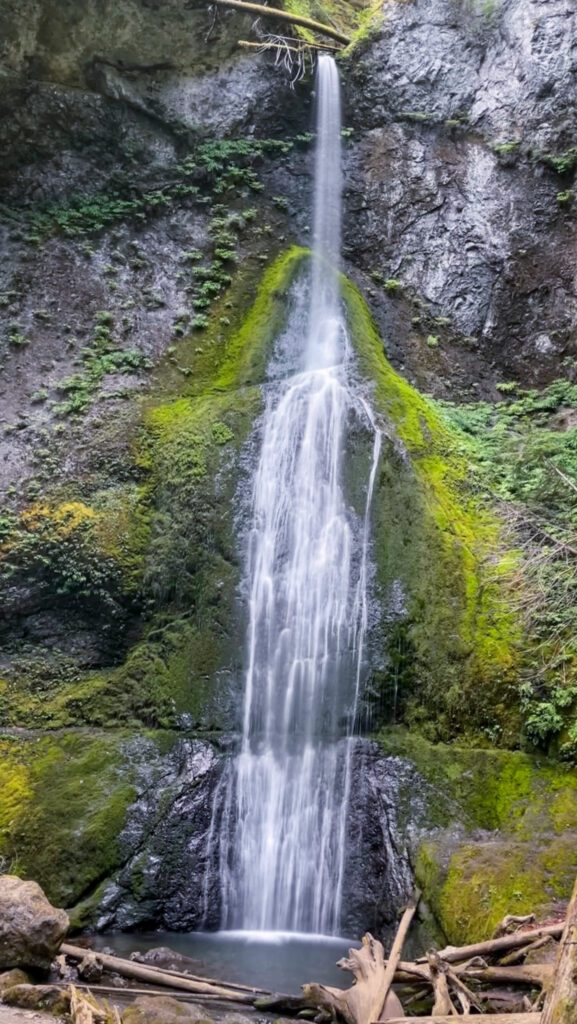
- Region: Olympic National Park
- Drive Time / Distance From Seattle: 3 hours / 105 miles
- Pass Required: None
- Hike Distance: 1.8 miles
- Elevation Gain: 500 feet
- Trailhead Location
The lush Marymere Falls are located just about a 20-mile drive from Port Angeles on the Olympic Peninsula. There is a large parking lot for both Lake Crescent and Marymere Falls that are not far from Storm King Ranger Station.
From the lot, follow along a gentle path through shadowy forest foliage. Walk beneath towering green conifer canopies, along carpets of moss, and over a couple of creeks before reaching the stunning Marymere Falls.
This 90-foot waterfall has two viewpoints, one from above and one from below. Catch views looking down on the waterfall from the hillside, watching as they plunge down through a moss-covered cliff.
You can also admire the falls from a lower platform, enabling you to observe Marymere from the base of the falls. The hike is short but sweet, offering a perfect taste of the lush Olympic Peninsula.
If you wish to extend the excursion, you can follow the path running parallel to Barnes Creek downstream that will lead you to the Lake Crescent Lodge, a historic northwestern lodge situated on Lake Crescent with a tasty restaurant offering serene lake views.
Snoqualmie Falls
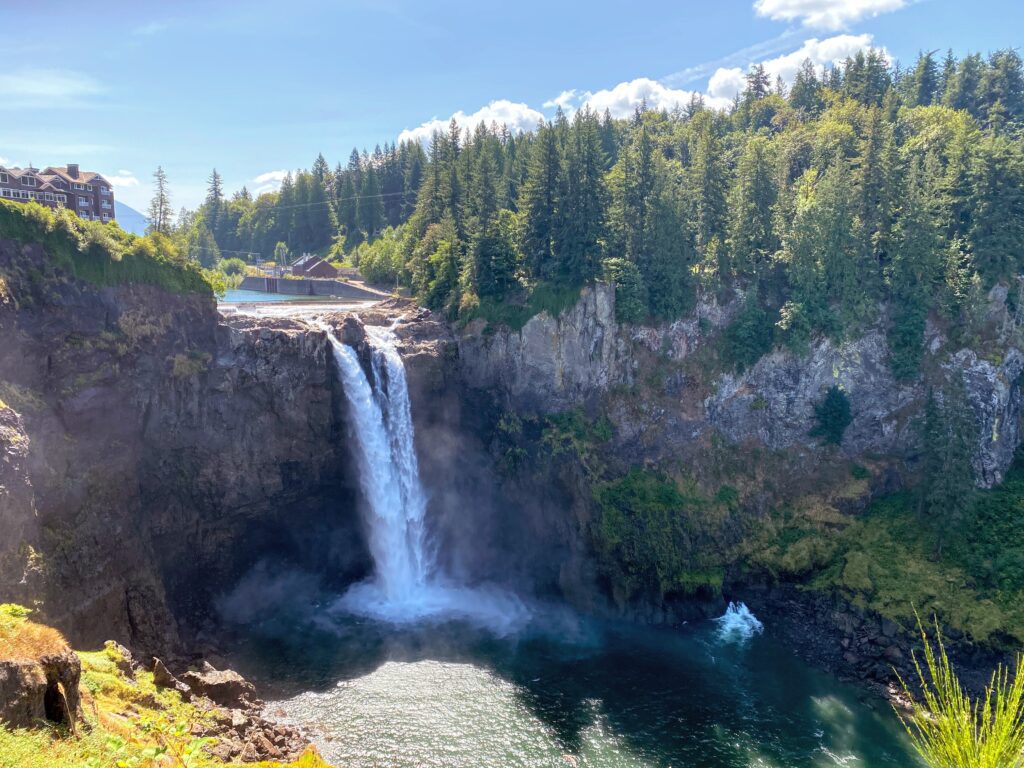
- Region: Snoqualmie Pass
- Drive Time / Distance From Seattle: 30 minutes / 30 miles
- Pass Required: None
- Hike Distance: 1.4 miles
- Elevation Gain: 250 feet
- Trailhead Location
The most famous and most visited waterfall in Washington State, the mighty Snoqualmie Falls are known for their powerful waters that cascade down 268 feet.
Snoqualmie Falls are a result of glaciers that receded thousands of years ago, leaving a fertile plain near the falls. Snoqualmie, which comes from a Salish word meaning “moon,” holds a spiritual place in the native tribes of the region, who consider the falls to be humanity’s place of origin.
The plains around Snoqualmie River and Falls were rich in berries, roots, deer, and mountain goats, and became a meeting place for trade. In more recent history, the falls have also provided hydroelectric energy to the region over the last century.
Snoqualmie Falls are an easy day trip from Seattle or as a stop while on route from the city to Snoqualmie Pass or across the mountains. Head east on I-90 from Seattle for about half an hour and you’ll find a large establishment for Snoqualmie Falls, including a parking lot that fits around 50 cars.
Note that there are multiple parking lots here. There’s a paid upper parking lot that costs $7, and a free parking lot across the street that just involves a short walk to the viewpoints for the falls. The lower lot also costs $7.
There are a number of viewpoints and paths to explore around Snoqualmie Falls. At the start of the trail – that’s at the top of the falls – you’ll find helpful signs providing information on the history, flora and fauna, and native culture around Snoqualmie Falls.
The trail starts at a somewhat steep descent enveloped by cedar, fir, and maple trees that lead to a short and flat walking path parallel to the river. Each section offers a unique viewpoint to the waterfalls and the river, immersing you into the roaring rush of water and the refreshing spray.
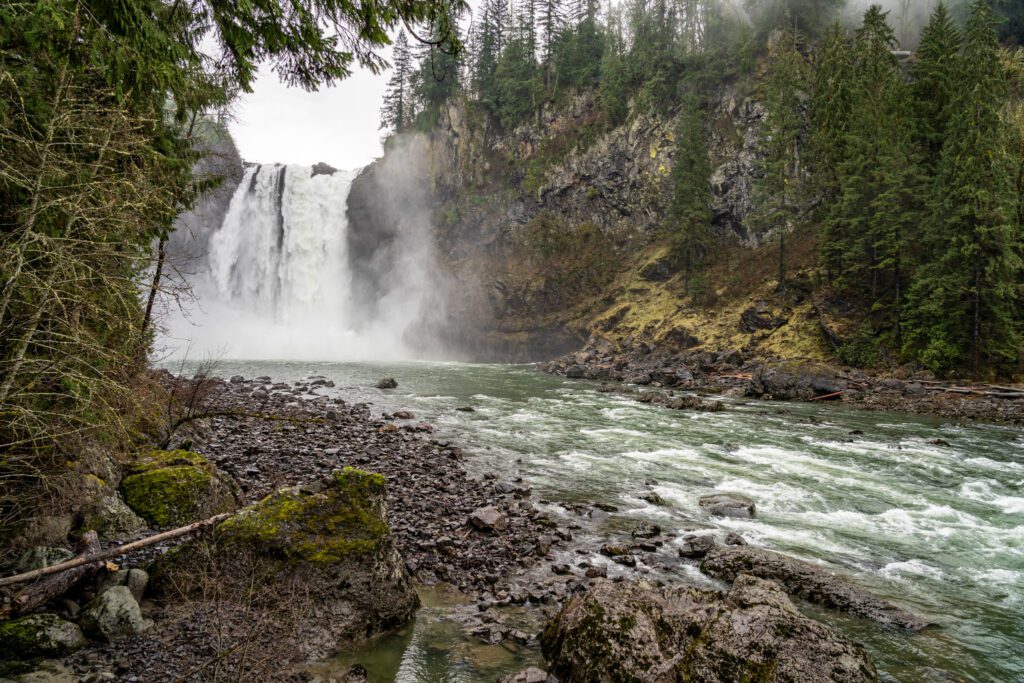
Each season brings a different personality to the falls, which are particularly roaring in the spring as the snow is melting. Enjoy watching massive sheets of water cascading into the river below as fog and mist circles trees in the backdrop. The only downside is that you’ll be sharing the views with many other visitors, regardless of the time of the year.
There is a well-developed Visitor’s Center, restaurant, stylish hotel, and boutique gift shop by the falls should you wish to extend your stay.
The Salish Lodge does make for a cozy getaway from the city for a quick and cozy weekend or midweek getaway.
Wallace Falls
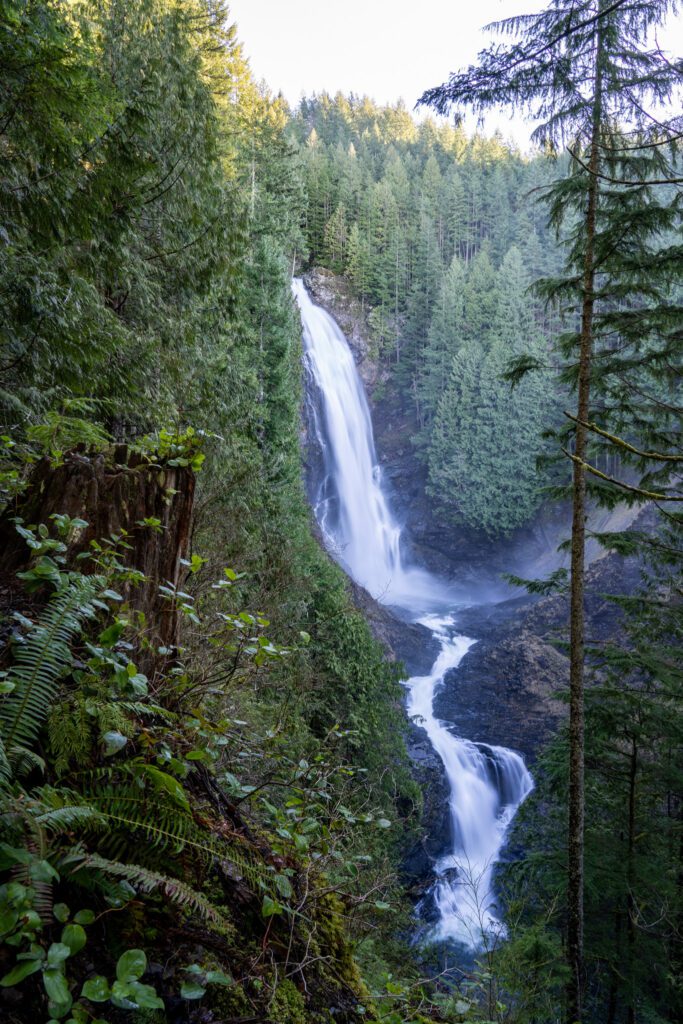
- Region: Central Cascades / Stevens Pass (Highway 2)
- Drive Time / Distance From Seattle: 1 hour / 50 miles
- Pass Required: Discover Pass
- Hike Distance: 5.6 miles
- Elevation Gain: 1,300 feet
- Trailhead Location
As you traverse into the dense forest, you’ll be greeted by massive sheets of white water cascading down through trees and into a river below. Although Wallace Falls requires a bit of a hike in, it is well worth the effort as the journey along the way is almost as spectacular as the cascading falls themselves.
P.S. Make sure to read our guide to the Wallace Falls Trail, which has all the information you need to tackle this surprisingly difficult hike.
Technically, there are nine falls from three main sections within Wallace State Park and even if you aren’t up for climbing to the highest viewpoints, you can still catch phenomenal views from the lower and middle viewpoints. The Lower Falls are a combined 212 feet, the Middle Falls 260 feet, and the Upper Falls 100 feet.
To reach Wallace Falls State Park, head towards the town of Gold Bar, which is east of Everett, along Highway 2, and park at the Wallace Falls State Park parking lot. The lot is spacious, but it is a popular spot particularly on weekends so arrive early to ensure finding space.
If you choose to hike the full route, the loop is 6.5 miles round trip with 1,300 feet elevation gain. Much of the hike follows Wallace River through lush, green foliage. At two miles in, you’ll find yourself at the Lower Falls.
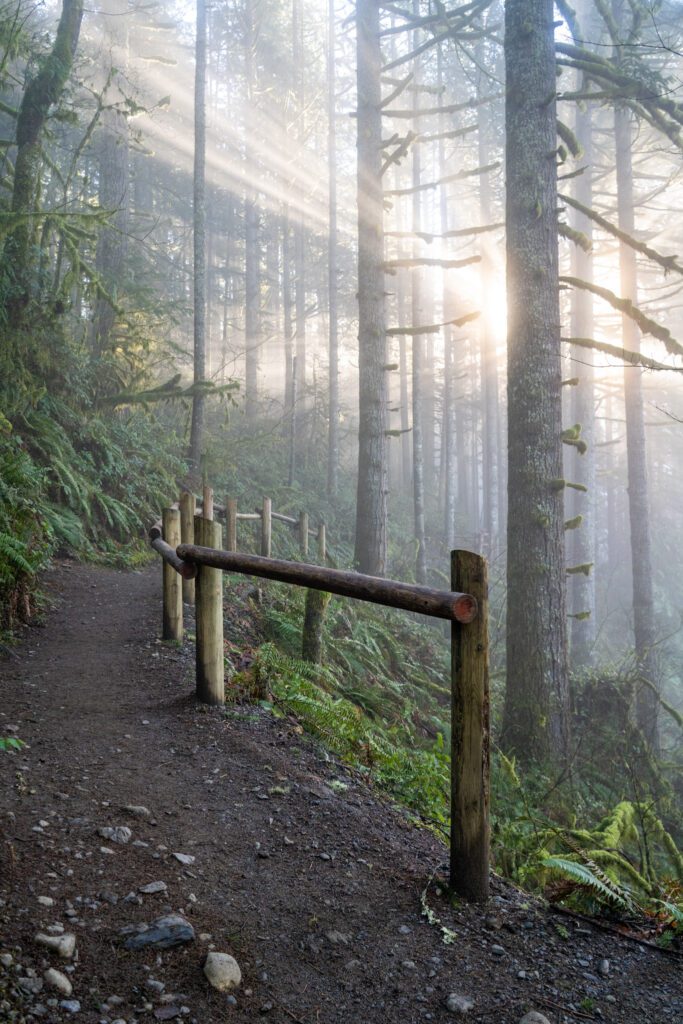
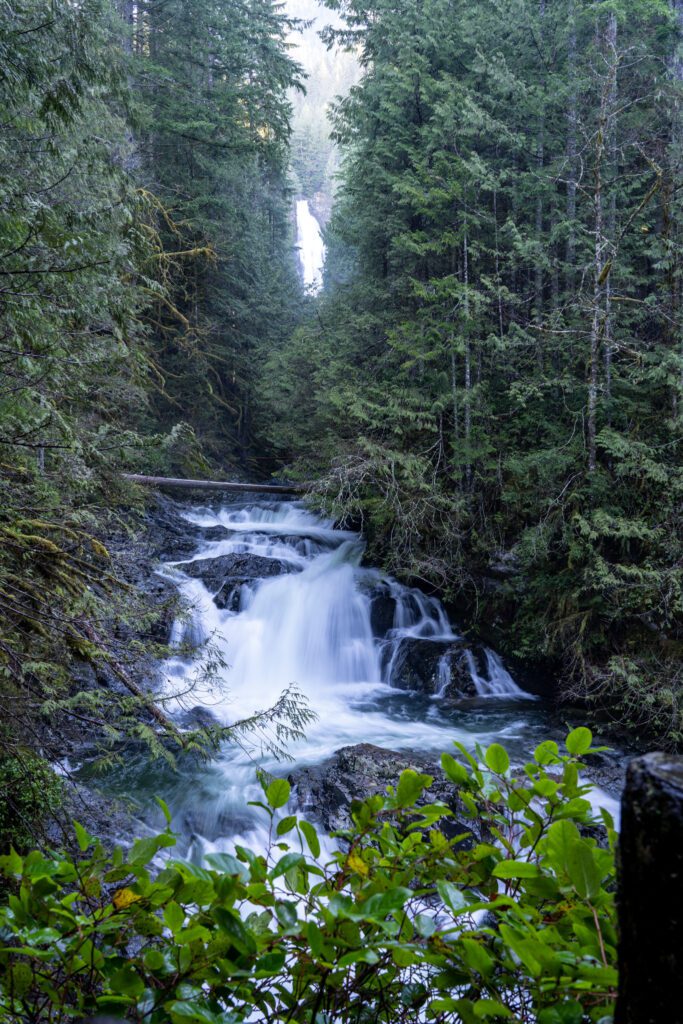
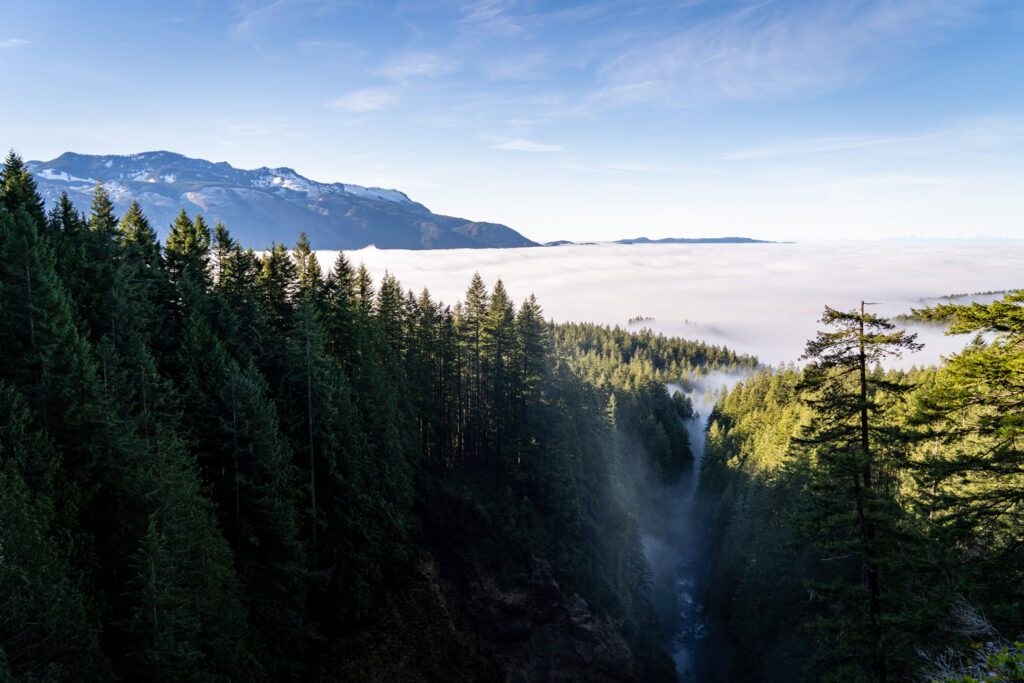
Keep pushing until you reach the Middle Falls, which offers even more dazzling views of Wallace Falls and panoramic views of Skykomish River Valley and a distant silhouette of the Olympic Mountains.
You can choose to turn around here if you’re intimidated by a bit of a steep climb or if chasing waterfalls is your thing and you enjoy the adventure, then keep pushing a final half mile on pretty steep switchbacks to reach the sight of the Upper Falls plunging into Wallace River below.
You’ll get pretty sweaty on the half-mile of switchbacks to reach the Upper Falls, but the challenge is part of the fun (at least in my opinion) and the views at the top are a worthy reward. While the falls are certainly the main attraction, the entire trail is absolutely beautiful.
Twin Falls
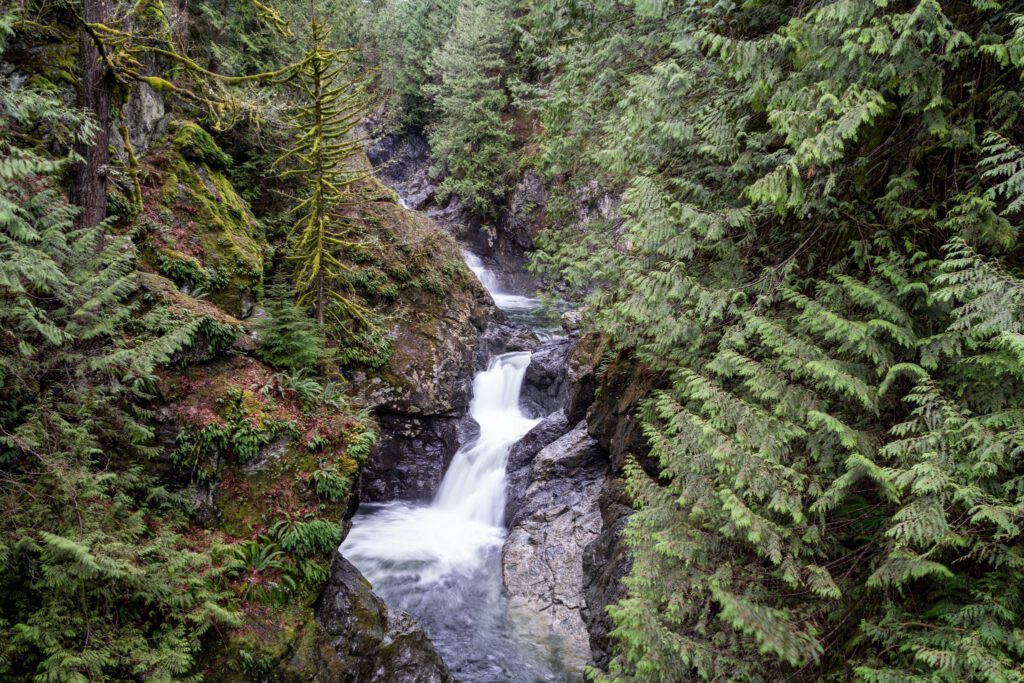
- Region: Snoqualmie Pass
- Drive Time / Distance From Seattle: 35 minutes / 35 miles
- Pass Required: Discover Pass
- Hike Distance: 2.6 miles
- Elevation Gain: 500 feet
- Trailhead Location
Just over half an hour drive east of Seattle, the Twin Falls come cascading out of rocks enveloped by dense forest into a pool below. The hike to the best viewpoint of the falls is just over 2.5 miles roundtrip and starts from the Twin Falls parking lot or from the Homestead Valley Trailhead.
The Twin Falls trail is a popular one, so know that you’ll be sharing the trail and viewpoints with other eager waterfall chasers.
Although the hike doesn’t involve significant elevation gain, it does involve a number of slippery scrambles and switchbacks. You will be able to catch some waterfall views along the way, including a fantastic viewpoint from a bridge you’ll cross.
However, much of the hike is below a valley, which limits views of the falls until further along. Instead, admire spring and summer wildflowers blooming in grassy meadows along the way.
After the first hill, you can stop and admire a view of the Lower Falls at The Benches. Be wary of the winds that tend to slam through this area. Depending on the wind conditions, you may want to make this stop a brief one and keep trekking to the top.
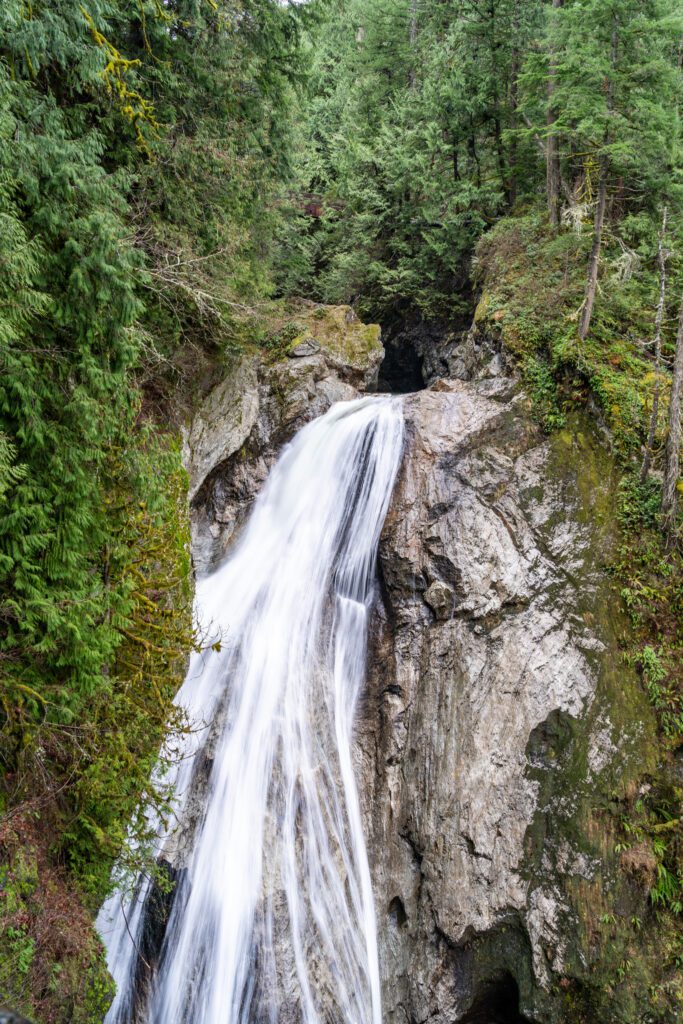
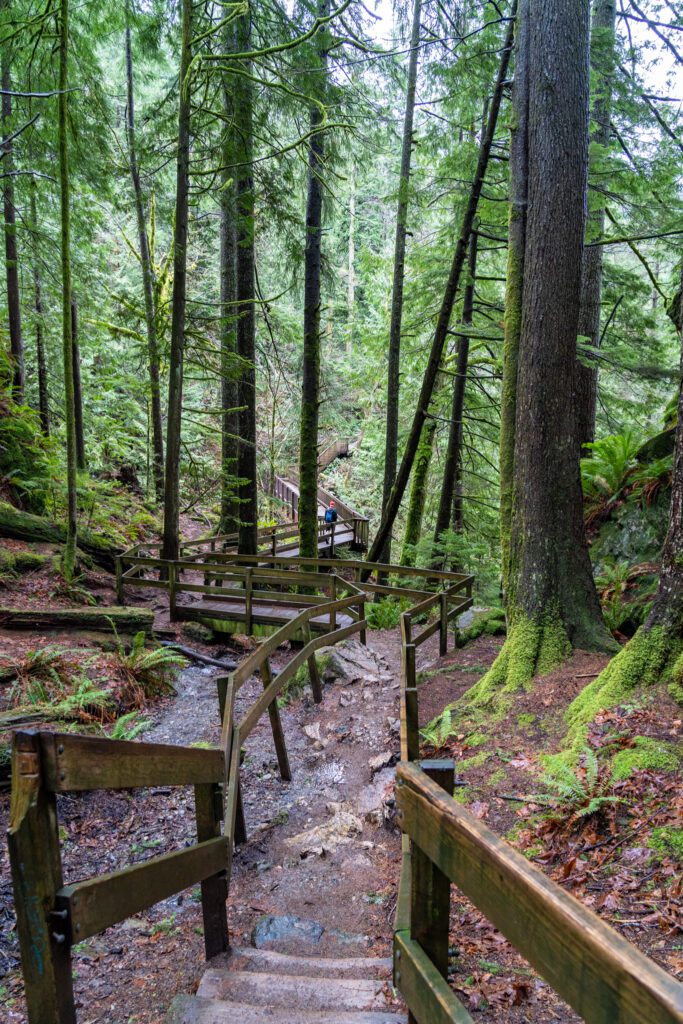
You’ll face a couple of steep descents and ascents as you continue along, soon reaching the best views of the Lower Falls. Before you reach the main attraction of Twin Falls—the Upper Falls—you’ll cross a large bridge with pretty spectacular views of the valley and smaller falls.
Although these falls are known as the “Twin Falls,” there are technically three falls in the collection. Once you’ve hit the bridge, you’ll just have a few stairs and a slope to climb before reaching the best view of the Upper Falls.
This popular hike is well worth it for the views and lush vegetation. The total height of the falls is 230 feet, and the tallest drop is 135 feet.
Sol Duc Falls
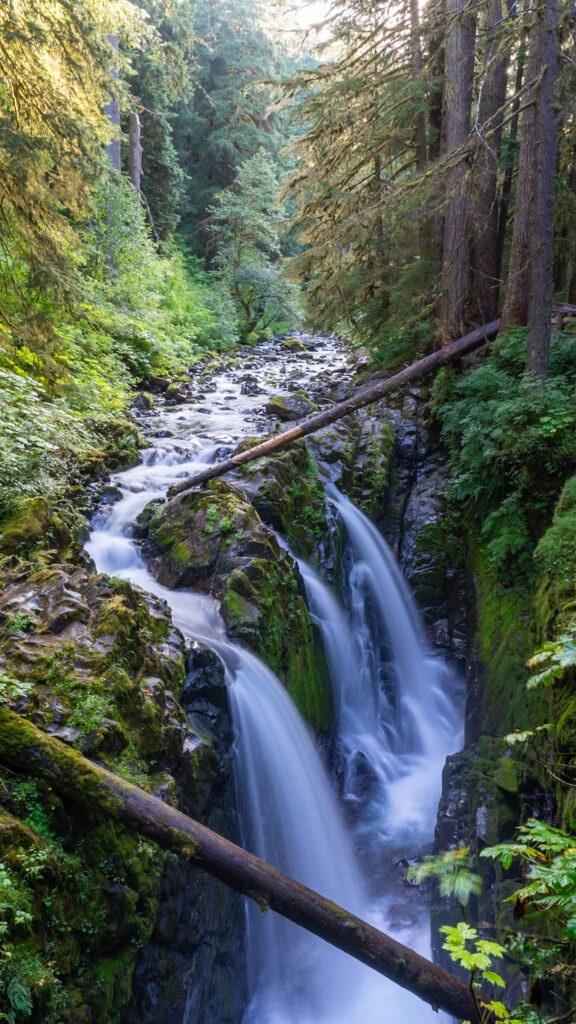
- Region: Olympic National Park
- Drive Time / Distance From Seattle: 3 hours 45 minutes / 125 miles (with a ferry)
- Or 4.5 hours / 222 miles without a ferry
- Pass Required: America the Beautiful Pass
- Hike Distance: 1.6 miles
- Elevation Gain: 200 feet
- Trailhead Location
Sol Duc Falls are one of the most popular attractions in Olympic National Park. When paying a visit to these falls, you’ll have the opportunity to experience old growth trees, lush rainforest, cascading falls, alpine lakes, and snow-capped peaks all in one place.
Pretty much the perfect mix of Pacific Northwest magic all in one place, in my opinion. The Olympic Peninsula is home to some of the most mesmerizing landscapes that never fail to enchant me and a visit to Sol Duc Falls is no exception.
To reach the falls, drive west for a fair distance from Port Angeles, passing the hot springs until you reach a parking lot at the end of the road. The route to Sol Duc Falls is less than a mile along a well-maintained path through a dense, vibrantly green forest canopy.
Sol Duc is shorter compared to many other Washington State waterfalls, tumbling only 48 feet down a rocky canyon.
Despite their shorter stature, Sol Duc Falls are quite spectacular. The falls cascade down moss-laden rocks and take on a different façade each season, with the streams varying in number and volume from spring to summer.
You can take in the Sol Duc Falls from a number of viewpoints, including from a small bridge crossing over a stream. The morning and evening light make for a particularly memorable experience, as the light and shadows reflect in the mist of the falls.
Falls Creek Falls
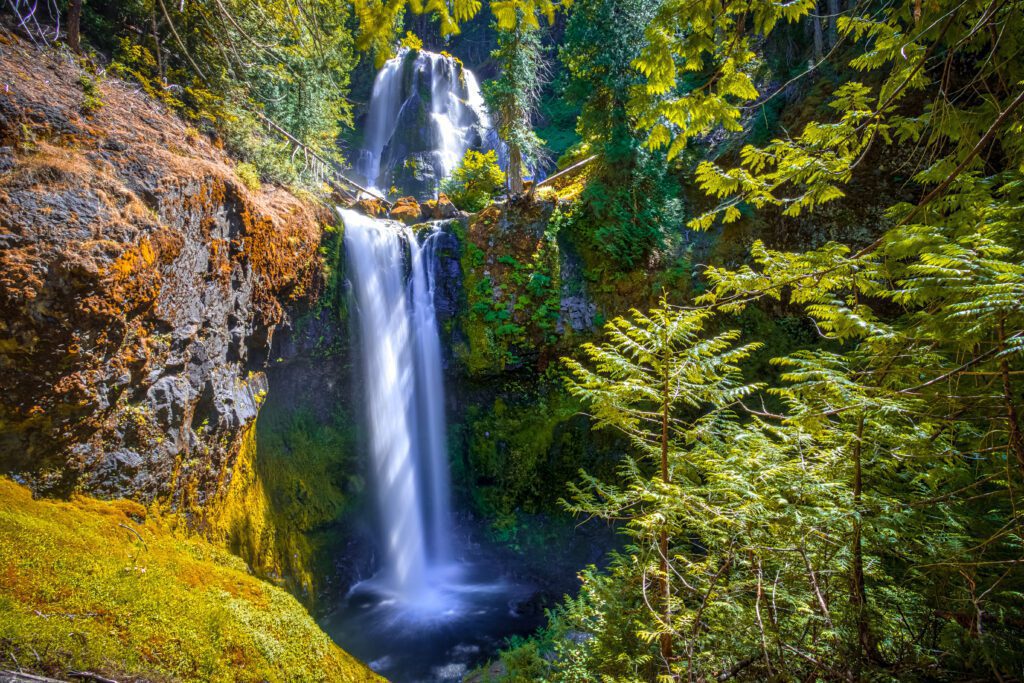
- Region: Columbia River Gorge (Gifford Pinchot National Forest)
- Drive Time / Distance From Seattle: 4 hours / 230 miles
- Pass Required: Northwest Forest Pass
- Hike Distance: 5.3 miles
- Elevation Gain: 1,118 feet
- Trailhead Location
The beautiful Falls Creek waterfalls are some of the highest falls in southern Washington and an absolute Pacific Northwest wonder.
These 335-foot falls are situated in the Central Gorge area in Gifford Pinchot National Forest. The falls drop in three tiers, cascading down a number of segments before the final drop, which plunges into a narrow gorge.
Falls Creek Falls are located in southwestern Washington in the vicinity of the Columbia River Gorge on the Washington side. To reach the starting point, you’ll drive through White Salmon and the tiny town of Carson and continue along Wind River Highway. After a few more turns on to forest roads, you’ll end up at a parking lot and trailhead for Falls Creek.
From the trailhead, you’ll head out on Falls Creek Trail 152A. The trail is easy and enjoyable, winding its way along the rushing stream of Falls Creek. You’ll be able to admire the creek’s whitewater from a suspension bridge over the rock gorge.
Once you reach the base of the falls, you’ll find three different tiers, including a 109-foot fall, a 135-foot drop over several segments, and finally a 91-foot drop into a narrow gorge. You may get drenched from the spray from this one, but the views are surely worth it.
Panther Creek Falls
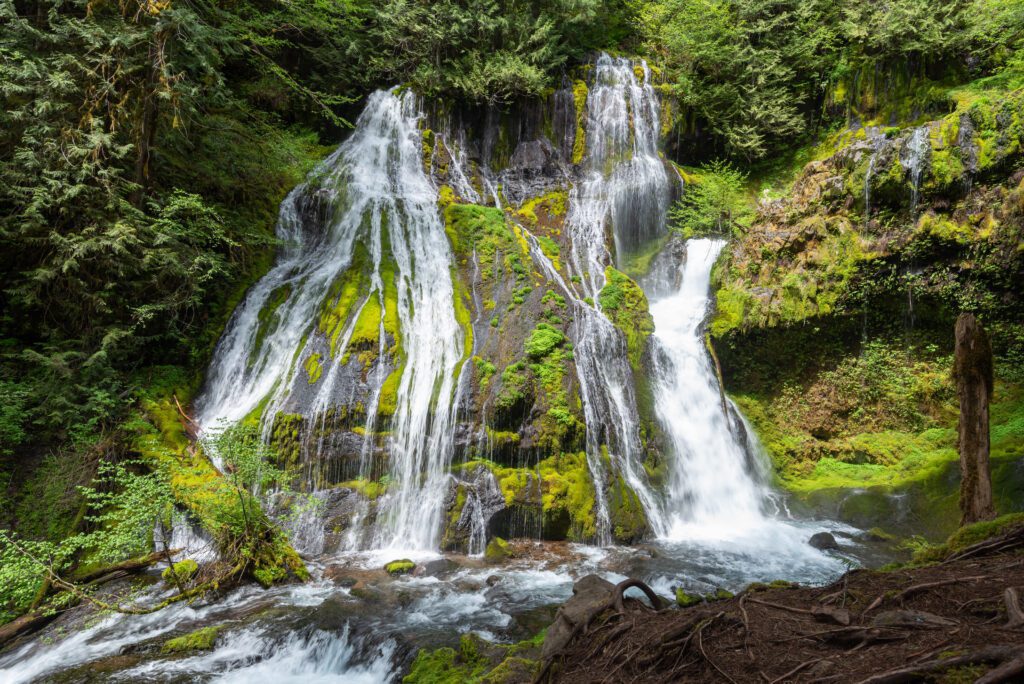
- Region: Columbia River Gorge (Gifford Pinchot National Forest)
- Drive Time / Distance From Seattle: 4 hours / 225 miles
- Pass Required: None
- Hike Distance: 0.2 miles
- Elevation Gain: 100 feet
- Trailhead Location
Panther Creek Falls are everything you expect from these Washington waterfalls: white waters cascading down moss-laden rocks amidst dense foliage. These falls are located around the fascinating landscapes of the Columbia River Gorge in Gifford Pinchot National Forest.
The starting point for these falls is several miles past the Panther Creek Campground, where you can find parking on the right hand side near the trailhead. Panther Creek Falls is accessible for everyone as it’s only a very short hike to reach the falls. Note that the trail isn’t particularly well marked, however it is well-maintained and has a viewing deck from which to enjoy the waterfall.
The trek to reach Panther Creek Falls is short and sweet with a lovely reward awaiting you. Admire veils of water spilling 100 feet down mossy rock faces: the embodiment of a classic Pacific Northwest waterfall.
The waterfall is a spillover of Panther Creek, which plunges over a cliff in a two-tiered fall that empties into a basin below. As much as you may be tempted to adventure down to the base of the falls and the plunge pool, it is being restored and off-trail hiking will impede this process so stick to the main trail for this one.
Narada Falls
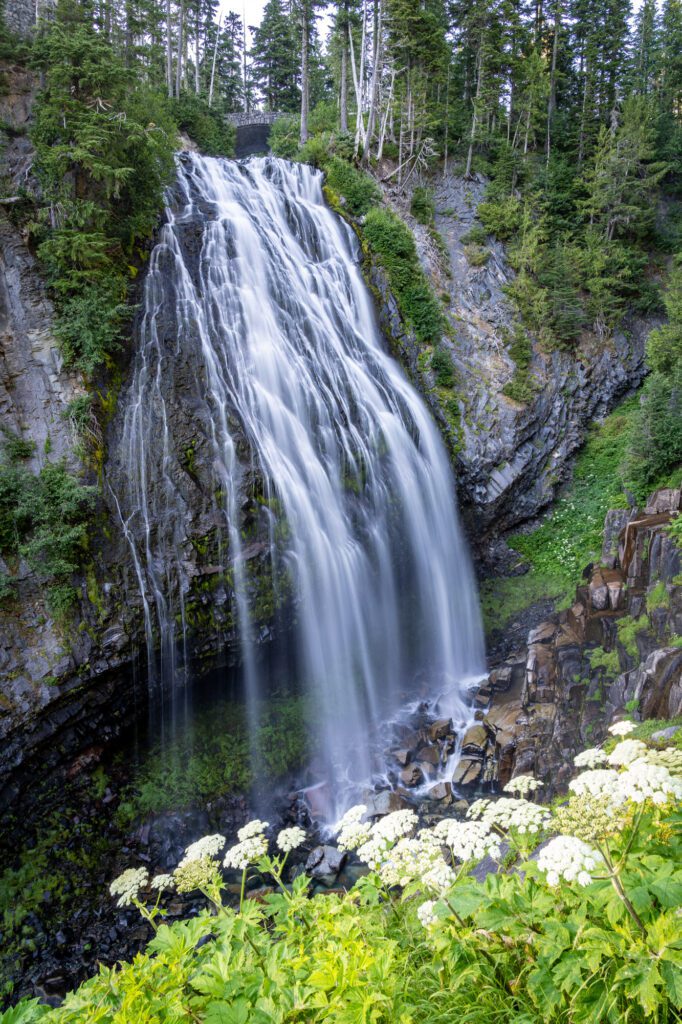
- Region: Mount Rainier National Park (Paradise)
- Drive Time / Distance From Seattle: 2.5 hours / 105 miles
- Pass Required: America the Beautiful Pass
- Hike Distance: 0.2 miles
- Elevation Gain: 100 feet
- Trailhead Location
Mount Rainier National Park has some of the most spectacular waterfalls in the state. Narada Falls are among the most frequented in the park, partly due to their accessibility. The quick, easy walk makes these impressive falls accessible for everyone.
Narada Falls are accessible from the Paradise Visitor Center parking lot—easily the most frequented section of the park— across a bridge and then down a short trail.
While the trail may be short, keep in mind that it is actually quite steep and frequently wet, which can make for a slippery trek. Even though you won’t be heading out on a strenuous hike for this one, you still want to have sturdy footwear to ensure that you won’t slip and fall on the way down.
After a short but steep descent, you’ll reach the viewing point for Narada, which is almost always wet and enveloped by swirling mists. Narada Falls is impressive from whichever angle you view from. The falls are about 50-feet wide and drop nearly 168 feet out of an andesite lava face.
You can choose to turn around after experiencing the splendor that is Narada or you can continue along the trail, which connects to the Wonderland Trail and gives you the option to hike to Reflection Lakes on a loop of three or five miles, depending on your preferred route.
Myrtle Falls
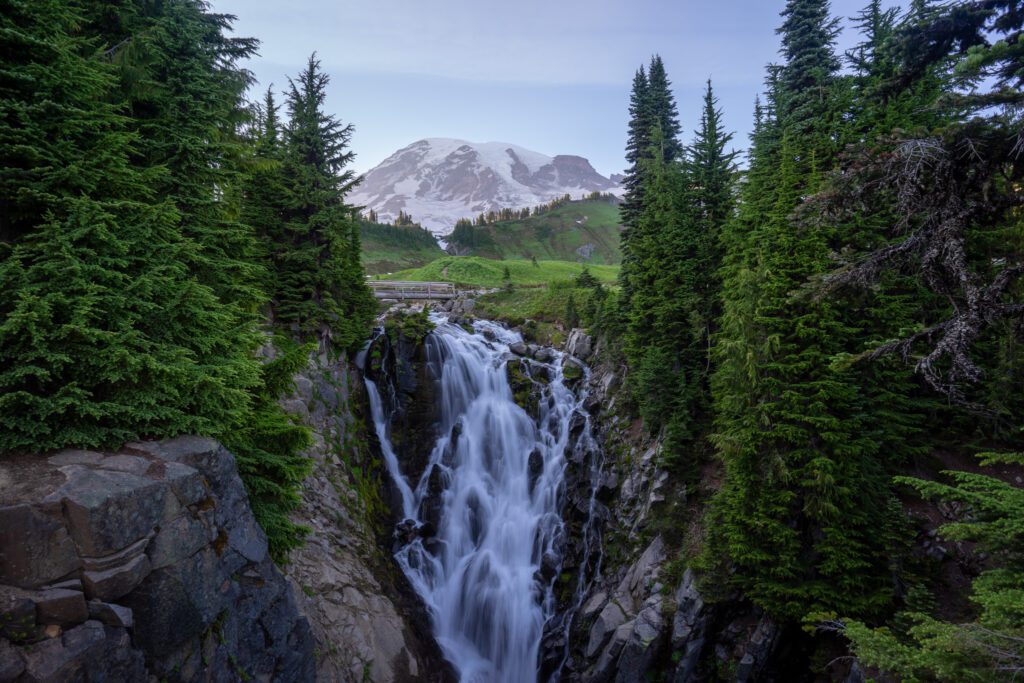
- Region: Mount Rainier National Park (Paradise)
- Drive Time / Distance From Seattle: 2.5-3 hours / 110 miles
- Pass Required: America the Beautiful Pass
- Hike Distance: 0.8 miles
- Elevation Gain: 185 feet
- Trailhead Location
Rushing water tumbling 72 feet down a rugged gorge with the majestic Mount Rainier in the background distinguish Myrtle Falls as one of the most memorable waterfall experiences in Washington.
Myrtle Falls is another beautiful and easy-to-reach attraction from the Paradise visitor area in Mount Rainier National Park, which includes a huge parking lot and a Visitor Center.
The walk is just under half of a mile, leaving from the parking lot down along Skyline or Golden Gate trails on a paved route. The path is pleasant and filled with alpine wilderness glory, including brilliant flowers during the summer season.
Eventually, you’ll need to cross a footbridge over Edith Creek Basin to reach the Myrtle Falls viewpoint.
At the viewpoint, you can marvel at the rushing water tumbling down mossy boulders to the spectacular backdrop of evergreen trees and a snow-capped Mount Rainier.
One of the most photogenic views in the park (not that there is any shortage of such spots) that is accessible in less than a mile round trip. For the adventurous, you can choose to continue on for a longer hike or you can rejoin the trail and loop back to the parking area.
Comet Falls
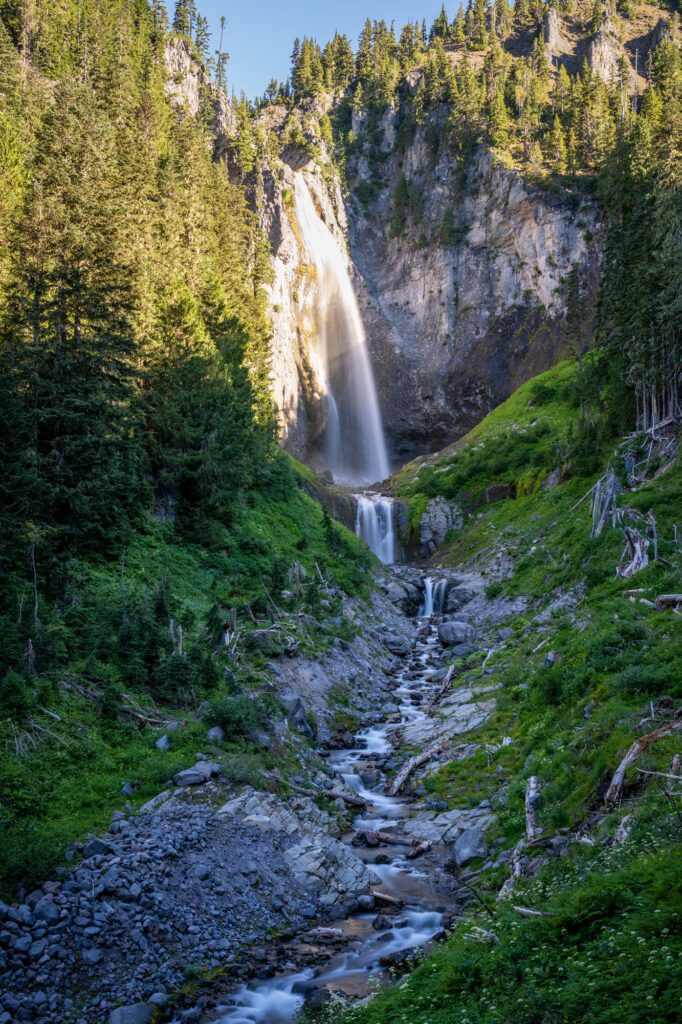
- Region: Mount Rainier National Park (Paradise)
- Drive Time / Distance From Seattle: 2-2.5 hours / 100 miles
- Pass Required: America the Beautiful Pass
- Hike Distance: 3.8 miles
- Elevation Gain: 1,250 feet
- Trailhead Location
A bit more of a trek than some of the more readily accessible waterfalls in Mount Rainier, Comet Falls are worth the journey if you’re up for it. Comet Falls are among the highest falls in Washington State, plummeting an impressive 320 feet down in a single plunge and perhaps the most impressive set of falls in Mount Rainier National Park.
While the dramatic Comet Falls are undoubtedly the attraction of the trail, you’ll be rewarded with a few smaller waterfalls and cascades along the way as well.
The trail to reach the falls starts at a parking lot for Comet Falls Trail, not far past the parking area for Christine Falls in the Paradise region of Mount Rainier. There is space for 16 vehicles and a few motorcycles with no amenities at the parking lot.
Leave the parking lot and cross over a bridge and across Van Trump Creek. The trail follows the creek for much of the way and even when you can’t see it, you’ll never be without the sound of the peaceful trickle in the background.
Over less than two miles from the trailhead to the falls themselves, you’ll encounter a spectacular array of sights, including many smaller falls. Wander slowly to admire the waterfalls and cascades, eventually reaching even more impressive sights.
Enjoy preliminary views of Comet Falls as well as the spectacular three-tiered falls plunging 124 feet and comprising Bloucher Falls. This is the perfect spot for a quick stop, especially on a sunny day when you may find yourself encircled by sparkling mist.
The most impressive views of Comet Falls are at the top of a series of switchbacks. If you’re keen to get even closer to the plunge pool, there is a small path to the left. Be aware of potential rockfall overhead and know that you’re likely to get drenched from this spot. The view might be worth it, however!
Franklin Falls

- Region: Snoqualmie Pass
- Drive Time / Distance From Seattle: 1 hour / 50 miles
- Pass Required: Northwest Forest Pass
- Hike Distance: 2 miles
- Elevation Gain: 400 feet
- Trailhead Location
Franklin Falls is a quintessential Washington State waterfall experience that leads you to tumbling falls and a large plunge pool through shady, thick forest.
To reach Franklin Falls, which are near Snoqualmie Pass, you’ll head east on I-90 and take the Denny Creek exit. Drive to the Denny Creek Campground and keep going for about a half of a mile until you reach the trailhead for Franklin Falls and a parking lot that will fit about 30 cars.
If this lot is full, head about a half mile further where there is a larger parking area that has room for about 60 cars. This is undeniably a popular destination so arrive early for best chances at finding parking. As you set out for the trail, look for the bulletin board in the parking lot and you’ll find the trailhead to Franklin Falls.
The trail is accessible for most skill levels, offering a gentle incline that climbs just about 400 feet over one mile. Although there are a few areas where the trail is a bit washed out, the trail is generally in great condition.
Bridges, steps, and walls have been added over the past several years in an effort to make the trail safe for young hikers and experienced trekkers alike.
The hike is pleasant and shaded, making it ideal even on a rare hot Washington day. Enjoy walking through leafy coniferous trees until you reach the spectacular Franklin Falls, cascading 70 feet down from tree-shrouded boulders.
Even though there are three tiers, only the last set of falls can be seen from the trails, which are most vibrant between April and July as the winter’s snow melts and feeds into the flow.
Whatcom Falls
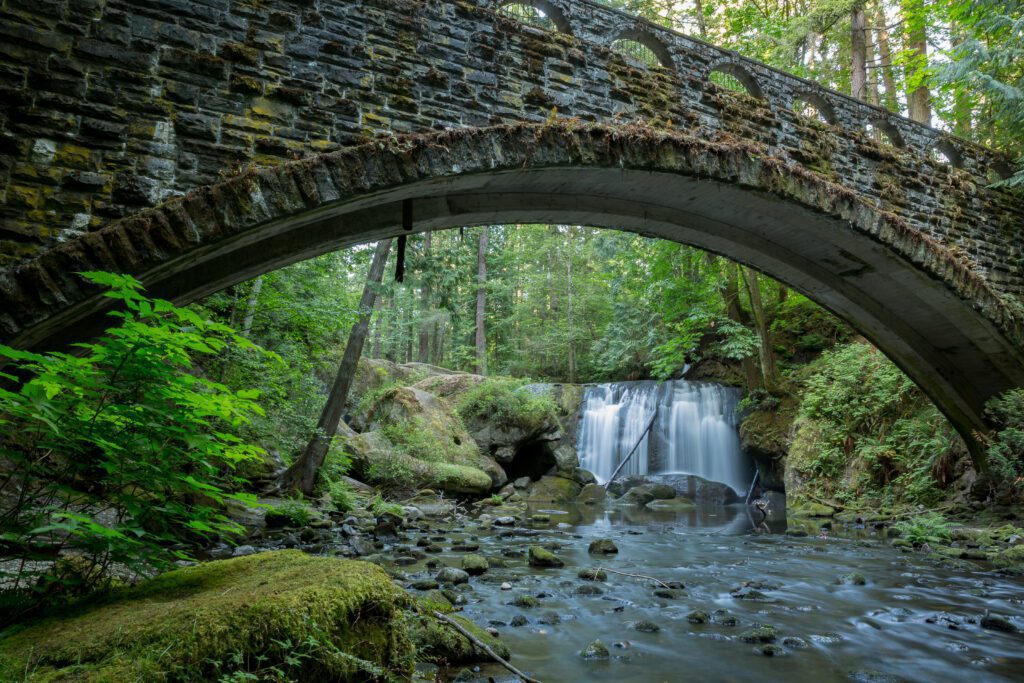
- Region: Bellingham
- Drive Time / Distance From Seattle: 1.5 hours / 90 miles
- Pass Required: None
- Hike Distance: 4 miles
- Elevation Gain: 50 feet
- Trailhead Location
Whatcom Falls are a series of shorter waterfalls that are easily accessible from the northwestern towns of Bellingham and Fairview.
The falls are a super popular area to hang out during the summer and many visitors choose to jump from the falls into the pool below (but only join in if you’re comfortable with cliff jumping! I once had an unfortunate mishap while cliff jumping and have avoided the exhilarating activity ever since). You can also relax in the pools below the falls if you wish.
These falls are located within Whatcom Falls Park. The entrance isn’t far off the Lakeview Drive exit on I-5 and has a spacious parking area. Inside the park, you’ll find a beautiful network of trails that wind their way through meadows and the forest, overlooking gorges and creeks.
Whatcom Falls are accessible from a one-mile loop that begins at the Silver Beach Road parking area. However, if you’re up for an adventure, you can also spend the better part of the day exploring the mossy wonders in the park.
Silver Falls
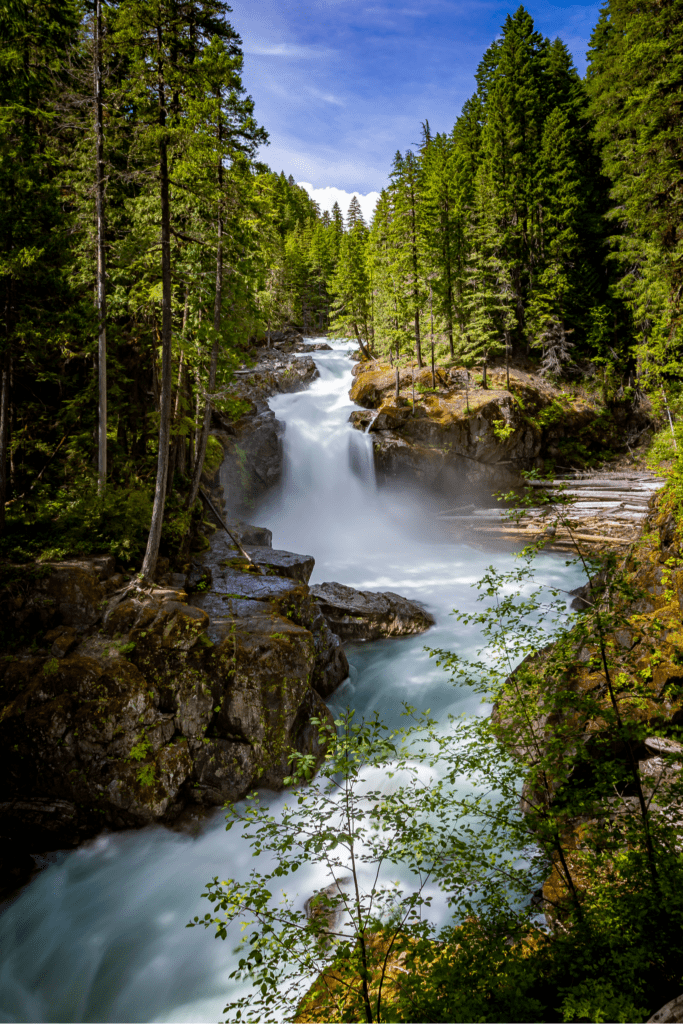
- Region: Mount Rainier National Park (Ohanapecosh)
- Drive Time / Distance From Seattle: 3 hours / 140 miles
- Pass Required: America the Beautiful Pass
- Hike Distance: 3 miles
- Elevation Gain: 600 feet
- Trailhead Location
Silver Falls are situated near the Ohanapecosh River in the southeastern corner of Mount Rainier National Park. These pretty falls cascade gradually down a gently sloping hillside, through trees and down mossy boulders.
While the drop might be less dramatic than other falls, Silver Falls makes for a pleasant hike that is easy and accessible for most fitness levels, without being too short. It makes our list of the best easy hikes in Washington for a reason.
The hike to Silver Falls begins from Ohanapecosh Campground, which is about 12 miles from Packwood or 60 miles from Enumclaw, is a further trek from Seattle than other waterfalls within Mount Rainier National Park. At the campground, there is a day use parking lot where hikers visiting the falls can park their car.
Head to the northeastern end of the campground where you’ll find Loop B, which is situated right on the riverbank.
The hike to Silver Falls begins here, starting on an easy trail through the forest. Follow the signs, as the path shortly veers to the right for Ohanapecosh Hot Springs Trail, but you’ll want to stay on the main trail. The loop takes you deep into the verdant forest with views of the rushing waters of Ohanapecosh River.
You’ll reach the viewpoint for Silver Falls about 1.5 miles along the loop. After descending down a set of switchbacks, you’ll come to a bridge, which is the prime viewing spot from which to marvel at the sight of the river churning beneath you as it tumbles into the waterfall below.
Once you’ve gotten your waterfall fix, pass the bridge and continue following the trail through open forest and across a mossy carpet parallel to the river.
Bridal Veil Falls
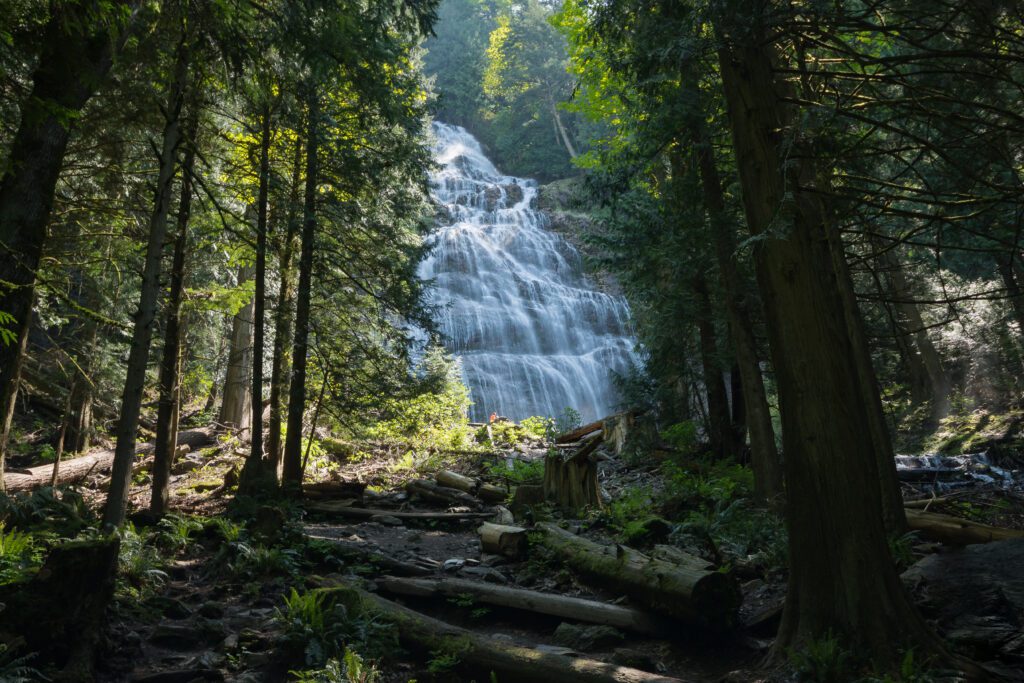
- Region: Central Cascades / Stevens Pass (Highway 2)
- Drive Time / Distance From Seattle: 1 hour 20 minutes / 55 miles
- Pass Required: Northwest Forest Pass
- Hike Distance: 4 miles
- Elevation Gain: 1,000 feet
- Trailhead Location
Bridal Veil Falls require a bit of a hike but if you’re up for adventure and can’t get enough of waterfalls, then this is the stop for you. These falls are linked to one of my favorite hikes in Washington: Lake Serene. Bridal Veil Falls flow out of Lake Serene, cascading down the rugged wall of Mount Index.
This hike is no secret and remains a favorite among local hikers, meaning that the parking lot fills up quickly. To reach the trailhead, you’ll pass through the small town of Gold Bar to Mount Index road. Follow the signs to Lake Serene Trail and you’ll find the parking lot, which may appear to be deceptively large. You’ll have better luck finding space during the week.
Enjoy a gentle start to the trail, winding through a forest of maples and old growth conifer trees and crossing a few streams. The last half mile of the trail is the challenge and will prove to be a good workout.
Stop to admire a view over the lower falls before starting the rocky, steep ascent, eventually ending at the spectacular Bridal Veil Falls, rushing down rugged rock faces enveloped by forest. If you’re an avid hiker and eager to keep exploring, you can continue to Lake Serene, which is about 1.5 miles further with another 1,300 feet of elevation gain.
While Bridal Veil Falls is a phenomenal sight on its own, Lake Serene is a splendid spot to kick back and enjoy a lunch among some of the finest Pacific Northwest scenery.
When to Experience These Washington Waterfalls
So, you think you’re ready to chase waterfalls in Washington but aren’t sure when to go? Most of the waterfalls are at their strongest during late winter through spring, typically from April to June.
The snow melt feeds into the falls, creating impressive, churning white cascades of water.
However, this is at odds with road and trail conditions to many of the waterfalls.
A lot of the falls are only reachable via trails that will be covered in snow through winter and spring and are thus only accessible during summer and fall. Many of the roads will also be closed (or have intermittent closures), particularly when trying to reach parts of Mount Rainier, the North Cascades, and when crossing Snoqualmie Pass.
Always read up on road and trail conditions before embarking on your waterfall-chasing adventure.
Waterfalls won’t dry up by summer, but they will be flowing at a reduced rate. Or, if you’re up for a challenge, you may consider snowshoeing in to see some of the waterfalls during early spring to catch them at their most brilliant.
MORE TO EXPLORE IN THE PACIFIC NORTHWEST
If you’re planning a trip to the Pacific Northwest, we’ve got you covered with all sorts of super detailed travel guides to our favorite places in Washington and Oregon.
- Seattle: Find the perfect place to stay in Seattle, use our itinerary and complete Seattle city guide to plan your weekend in Seattle (we also have a guide to one day in Seattle for shorter trips), find a new hike near Seattle to tackle, and plan your next day trip or weekend getaway.
- Portland: Get a local’s take on what to do in Portland and where to stay in Portland, plan your weekend itinerary (we also have a guide to one day in Portland for shorter trips), find the best hikes in and around Portland, and discover the best day trip and weekend getaway destinations.
- Road Trips: Explore the best of the Pacific Northwest on a 14 day Pacific Northwest road trip. Plan an amazing Washington road trip or Oregon road trip with our detailed guides, including a couple of itineraries that you can copy/paste.
- The Oregon Coast: Explore the best of the Oregon Coast on a 7 day Oregon Coast road trip. Discover the best hikes on the Oregon Coast, and figure out what to do in Cannon Beach and Astoria.
- Hiking in Oregon: Get a local’s take on the best hikes in Oregon, the most spectacular Oregon waterfalls, and dive deeper into each region with our guides to the best hikes at Mt. Hood, in the Columbia River Gorge, and more.
- Hiking in Washington: Add to your Washington hiking bucket list with our guide to the best hikes in Washington. Then dive into our regional hiking guides to discover the best hikes near Seattle, hiking at Mount Rainier, in Olympic National Park, in the North Cascades, and at Mount Baker.
- Mount Rainier National Park: Plan the perfect trip to Mount Rainier with our guides to the best things to do, the best hikes, and how to plan a perfect day trip to Rainier.
- Olympic National Park: Explore the best that Olympic National Park has to offer – the best hikes, a complete itinerary, and exactly where to stay in Olympic National Park.
- North Cascades National Park: The least visited of the National Parks in Washington, learn how to plan a perfect itinerary, and figure out the best hikes to add to your list.
- Crater Lake National Park: Discover the best that Oregon’s only national park (isn’t that crazy?) has to offer with our guide to planning your Crater Lake itinerary, and our guide to the best hikes in Crater Lake. Plus, a guide to planning an amazing Seattle to Crater Lake road trip.

